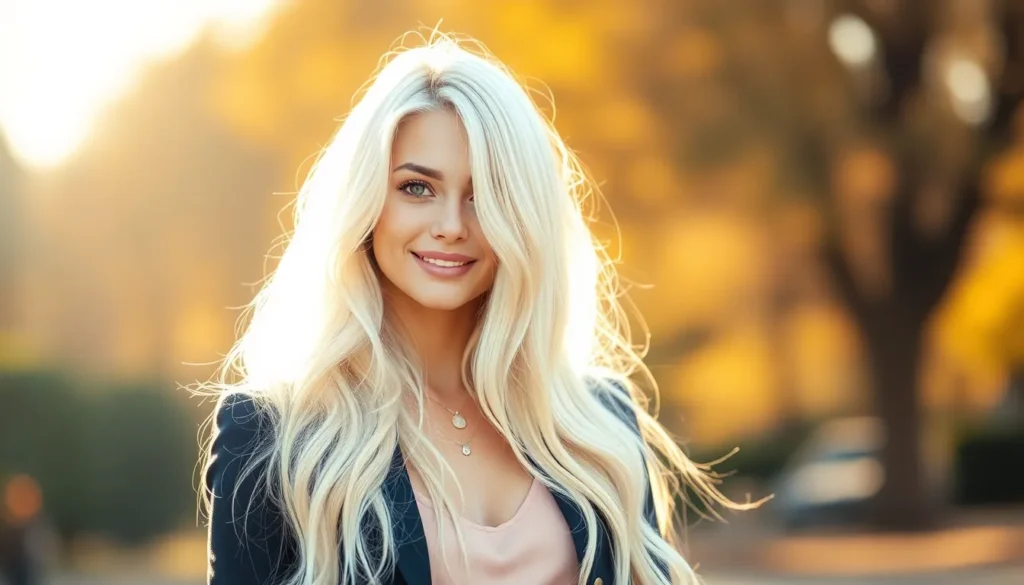Blonde hair never goes out of style but choosing the perfect shade can feel overwhelming with countless options available. From icy platinum to warm honey tones we’ve all wondered which blonde would complement our skin tone and lifestyle best.
The industry of blonde hair color offers incredible versatility with shades ranging from cool ash blondes to rich buttery highlights. Whether you’re looking to go lighter for the first time or switching up your current blonde we understand the importance of finding that perfect match that enhances your natural beauty.
We’ve curated the ultimate guide to 13 stunning blonde shades that’ll transform your look and boost your confidence. Each shade offers its own unique personality and works beautifully with different skin tones and personal styles making it easier than ever to find your ideal blonde.
Platinum Blonde: The Ultimate Ice Queen Look
Platinum blonde represents the pinnacle of cool toned blonde shades, delivering an ethereal and sophisticated appearance that commands attention. This ultra light shade creates a striking contrast against most skin tones while embodying modern elegance and timeless glamour.
Achieving the Perfect Platinum Tone
Lightening your hair to platinum requires multiple bleaching sessions spread across several weeks to prevent severe damage. Professional colorists typically recommend starting with naturally light brown or blonde hair to minimize processing time and maintain hair integrity.
Pre lightening treatments using bond builders like Olaplex help protect hair structure during the intensive bleaching process. Most clients need 2-3 salon visits to reach the desired level 10 or 11 lightness required for platinum.
Toning becomes crucial once you’ve achieved sufficient lift, as platinum blonde demands complete neutralization of yellow undertones. Purple based toners create the coveted icy finish while silver toners add depth and dimension to the final result.
Cool skin tones with pink or blue undertones complement platinum blonde beautifully, while warm skin tones may require strategic makeup adjustments to create harmony. Fair complexions often look stunning with this shade, though darker skin tones can create dramatic and striking contrasts.
Maintenance Tips for Platinum Hair
Purple shampoo becomes your best friend when maintaining platinum blonde, used 2-3 times weekly to prevent brassiness and yellow tones from developing. Quality purple shampoos contain violet pigments that neutralize unwanted warmth while preserving the cool tone.
Deep conditioning treatments should happen weekly to restore moisture and protein balance, as platinum hair requires intensive hydration to remain healthy and manageable. Protein treatments every 2-3 weeks help rebuild damaged hair bonds and prevent breakage.
Heat styling tools need temperature adjustments to prevent further damage, with most platinum blonde hair requiring settings below 300°F for optimal protection. Leave in treatments and heat protectants become non negotiable parts of your styling routine.
Professional touch ups every 4-6 weeks maintain root coverage and refresh the platinum tone, while glossing treatments add shine and seal the hair cuticle. Regular trims every 6-8 weeks prevent split ends from traveling up the hair shaft and compromising the overall appearance.
Sun protection for platinum hair includes UV filtering products and physical barriers like hats or scarves, as lightened hair becomes more susceptible to environmental damage and color fading.
Ash Blonde: Cool-Toned Elegance
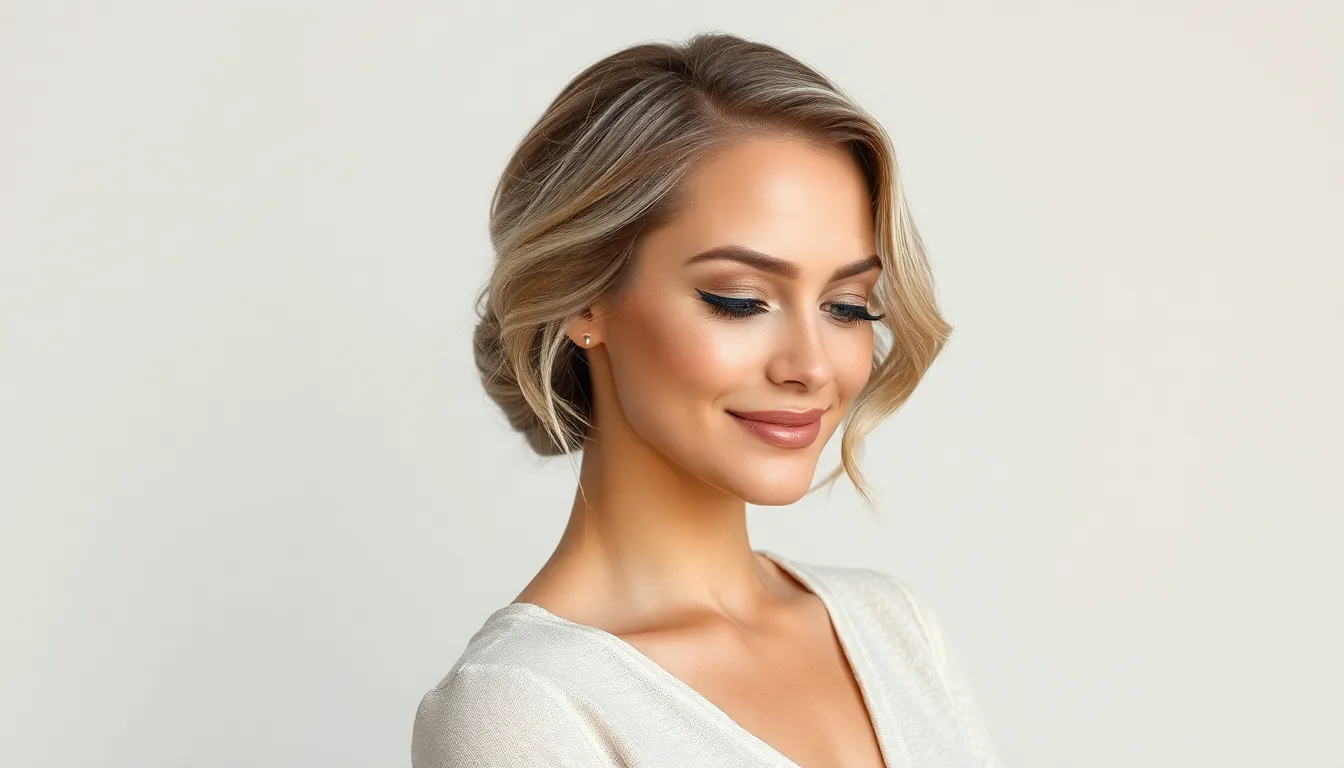
Ash blonde represents the perfect balance between sophistication and subtlety in cool toned hair colors. This elegant shade offers a refined alternative to warmer blonde tones while maintaining natural looking appeal.
Understanding Ash Undertones
Cool undertones define ash blonde’s distinctive character through gray and blue pigments that neutralize warmth. These undertones create depth and dimension that prevents hair from appearing flat or one dimensional. Silver highlights naturally emerge within ash blonde formulations to add luminosity without brassiness.
Professional colorists achieve ash tones by counteracting natural yellow and orange pigments in hair. The process requires careful color theory application since ash pigments neutralize unwanted warm tones effectively. Blue based toners work specifically to eliminate orange undertones while violet based products target yellow pigments.
Natural ash blonde develops when hair contains minimal warm pigments from the start. Artificial ash creation involves strategic color placement and toning techniques that build cool undertones gradually. Multiple toning sessions often produce the most authentic looking ash results compared to single application methods.
Best Skin Tones for Ash Blonde
Cool skin undertones complement ash blonde beautifully by creating harmonious color relationships. Pink undertones in the skin work exceptionally well with gray and silver ash pigments. Blue undertones also pair naturally with ash blonde since both colors exist within the same cool color family.
Fair complexions with cool undertones showcase ash blonde most effectively through natural contrast. Medium skin tones benefit from ash blonde when they possess pink or neutral undertones rather than golden ones. Olive skin tones can wear ash blonde successfully when the shade leans toward deeper ash variations.
Warm skin undertones require careful consideration before choosing ash blonde shades. Golden and yellow undertones in skin may clash with cool ash pigments creating an unflattering contrast. Neutral undertones offer flexibility since they can accommodate both warm and cool hair colors depending on the exact ash formulation chosen.
Honey Blonde: Warm Golden Sweetness
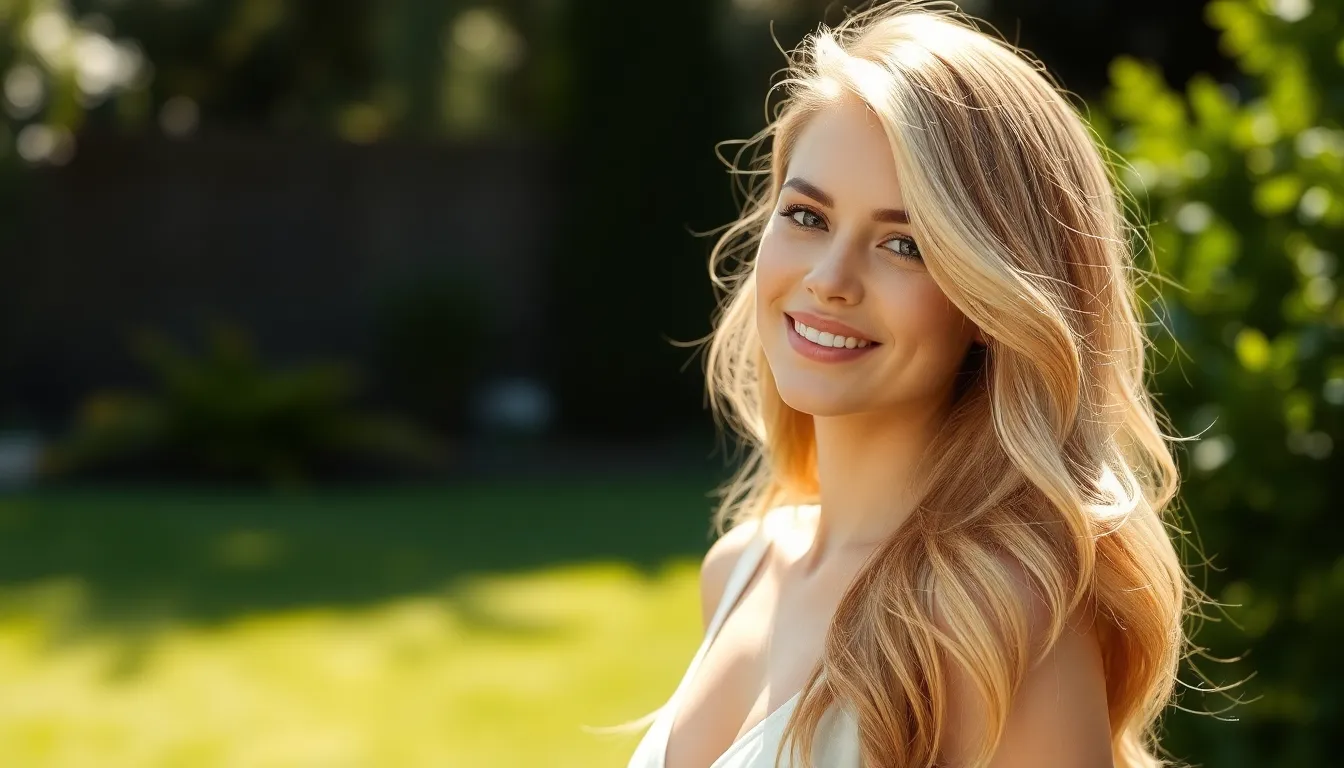
Honey blonde captures the essence of sun-kissed warmth with its luxurious golden undertones that complement a wide range of skin types. This versatile shade bridges the gap between light and medium blonde tones, offering natural-looking dimension that enhances your features without appearing overly processed.
Creating Natural Honey Highlights
Professional colorists achieve honey blonde through strategic highlight placement that mimics natural sun lightening patterns. Foil techniques work best for creating precise honey tones, allowing stylists to control the lightening process and prevent over-processing. Balayage applications offer a more organic approach, painting highlights onto sections where sunlight would naturally hit your hair.
Timing plays a crucial role in developing the perfect honey shade, with most sessions requiring 30 to 45 minutes of processing time. Toner selection determines the final warmth level, with golden and amber tones creating that signature honey glow. Base color considerations matter significantly since darker starting points need more lift to achieve the desired honey transparency.
Root placement should begin approximately one inch from the scalp to maintain a natural growth pattern. Sectioning techniques involve taking thin slices through the mid lengths and ends for seamless blending. Multiple appointment schedules often work better than single sessions for achieving optimal honey results while preserving hair health.
Styling Tips for Honey Blonde Hair
Heat protection becomes essential when styling honey blonde hair since lightened strands require extra care during thermal styling. Ceramic tools distribute heat evenly and reduce the risk of creating hot spots that could damage your honey tones. Temperature settings should stay between 300 to 350 degrees Fahrenheit for most styling techniques.
Texturizing products enhance the golden dimension in honey blonde hair by catching light at different angles. Sea salt sprays create natural waves that showcase the various honey tones throughout your hair. Lightweight oils add shine without weighing down the hair or dulling the golden reflections.
Color depositing shampoos help maintain honey warmth between salon visits by adding subtle golden pigments. Deep conditioning treatments should be used weekly to keep lightened hair moisturized and prevent color fading. UV protection sprays shield honey blonde from sun damage that can turn golden tones brassy over time.
Styling versatility allows honey blonde to work beautifully in both casual and formal looks. Beach waves complement the natural warmth of honey tones, while sleek straight styles showcase the color’s dimensional qualities. Braided styles highlight the interplay between different honey shades throughout your hair.
Strawberry Blonde: The Perfect Pink-Tinged Hue
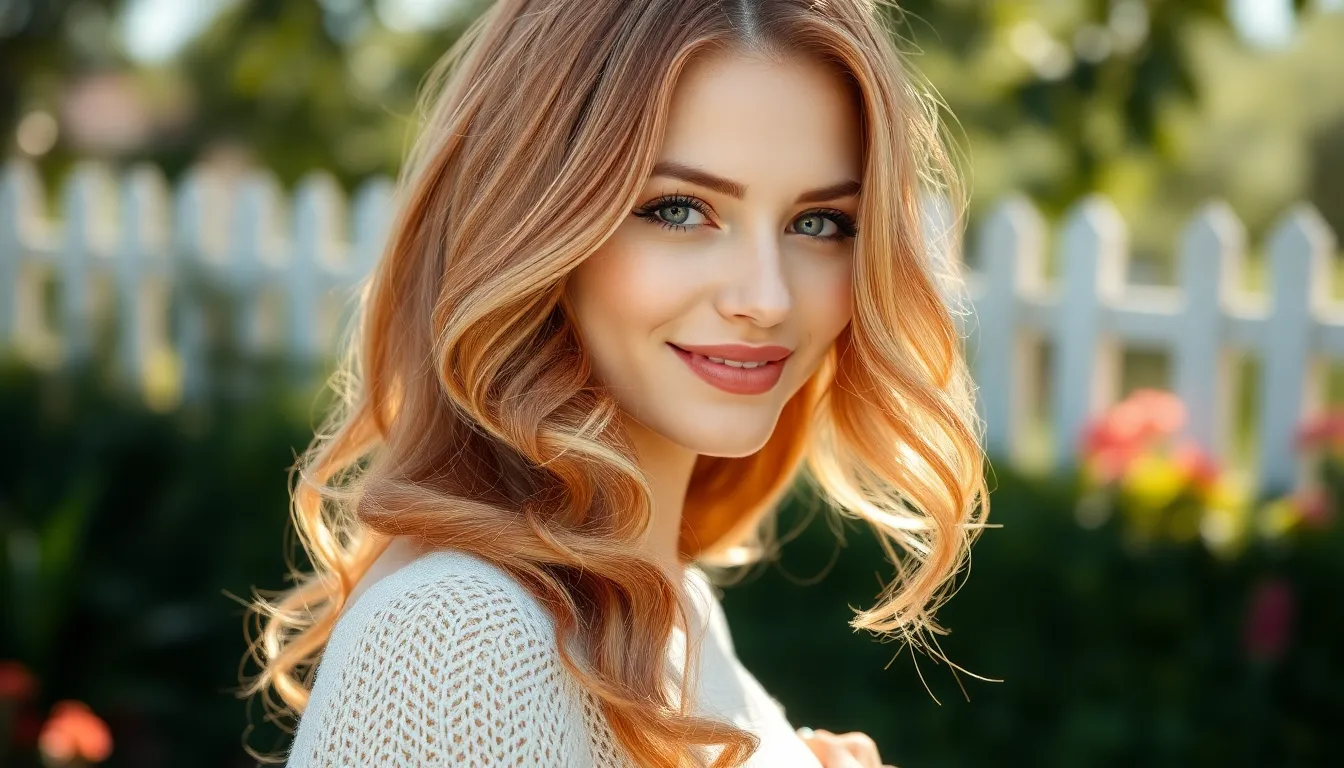
Strawberry blonde creates a stunning fusion of warm red and golden blonde tones that offers natural looking dimension. This romantic shade delivers subtle warmth without overwhelming cooler skin undertones.
Balancing Red and Blonde Tones
Creating the perfect strawberry blonde requires precise color formulation to achieve harmonious red and blonde balance. Professional colorists typically use a base of level 7 or 8 blonde with carefully measured copper and gold tones. We recommend starting with a lighter blonde foundation before adding red pigments to prevent muddy results.
Strategic placement becomes crucial when blending these contrasting tones throughout your hair. Colorists often apply lighter blonde shades to face framing pieces while incorporating deeper strawberry tones through the mid lengths and ends. This technique creates natural looking dimension that mimics how sunlight would naturally lighten hair.
Toner selection plays a vital role in achieving the signature strawberry blonde appearance. Rose gold and peach toners help neutralize any unwanted orange undertones while improving the pink red elements. We’ve found that copper based toners work exceptionally well for maintaining the warmth without creating brassiness.
Maintenance requires exact products designed for color treated hair to preserve both the red and blonde elements. Color safe shampoos prevent fading while sulfate free formulas protect the delicate balance between warm and cool tones. Deep conditioning treatments become essential since achieving strawberry blonde often involves lifting natural pigment before depositing the desired color.
Celebrity Inspiration for Strawberry Blonde
Amy Adams has become the quintessential example of strawberry blonde perfection with her natural looking red gold combination. Her colorist achieves this look through subtle highlights that blend seamlessly with deeper strawberry base tones. We notice how her shade appears more golden in bright lighting while revealing deeper red undertones in softer illumination.
Emma Stone showcased a stunning strawberry blonde transformation that demonstrated the versatility of this shade. Professional colorists created her look using balayage techniques that placed lighter blonde pieces strategically around her face. The result appeared effortlessly natural while providing important dimension and movement.
Jessica Chastain represents the more vibrant end of the strawberry blonde spectrum with her signature copper gold blend. Her colorist maintains the intensity through regular gloss treatments that enhance both the red and blonde elements. We observe how this approach creates a more dramatic strawberry blonde that still appears sophisticated and wearable.
Blake Lively has experimented with strawberry blonde variations that range from subtle to statement making. Her hair team often incorporates multiple tones within the strawberry blonde family to create depth and interest. These techniques include weaving in champagne highlights with rose gold lowlights for a multidimensional finish that catches light beautifully.
Dirty Blonde: Effortlessly Chic and Low-Maintenance
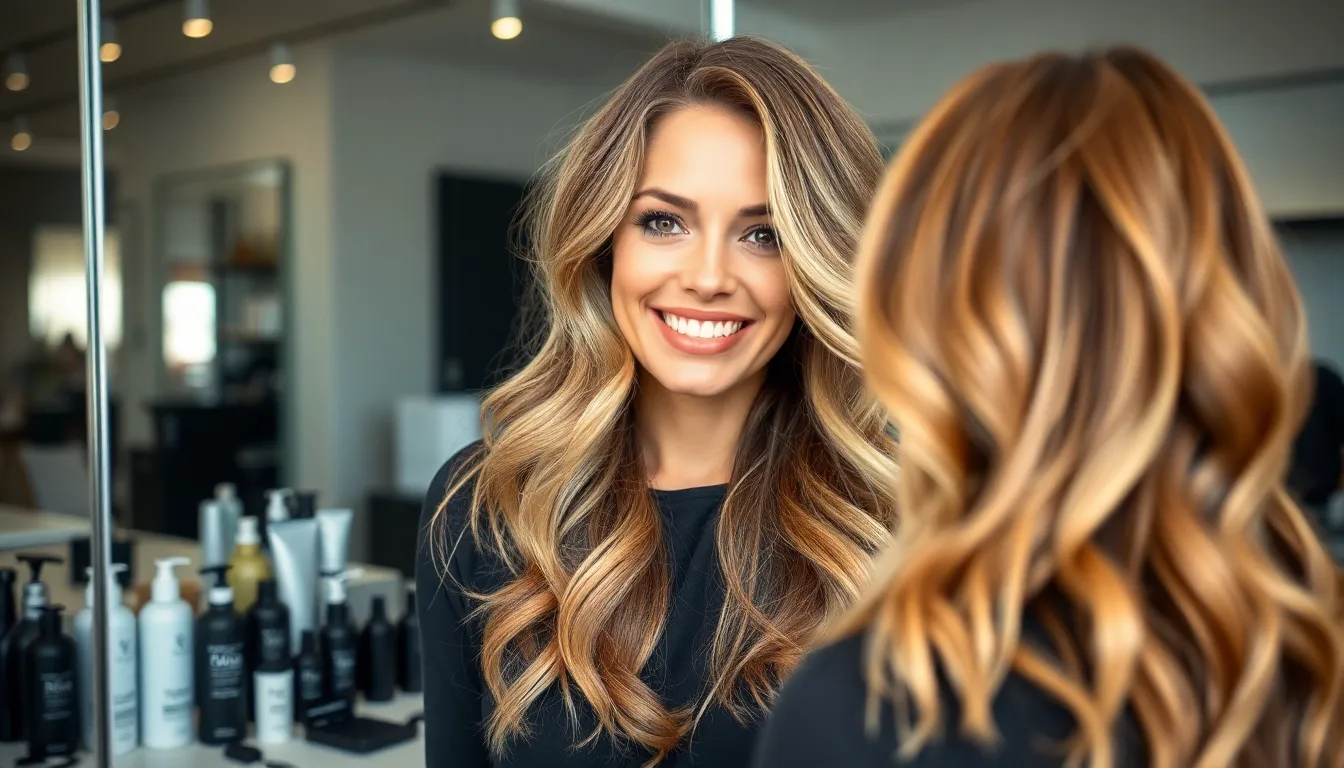
Dirty blonde strikes the perfect balance between natural charm and polished sophistication. This versatile shade offers busy individuals a gorgeous color option that doesn’t demand constant salon visits.
Achieving the Perfect Dirty Blonde Base
Professional colorists create dirty blonde by combining light brown and blonde tones in strategic ratios. The key lies in maintaining depth at the roots while gradually lightening toward the ends, mimicking natural hair growth patterns.
Base color selection determines the overall warmth or coolness of your final result. Cool-toned bases incorporate ashy undertones that neutralize brassiness, while warm bases embrace golden and caramel highlights that enhance natural dimension.
Lightening levels typically range from 4 to 6 on the hair color scale, preserving enough pigment to create that signature “dirty” effect. We recommend starting with your natural base color and lifting only 1-2 levels to maintain hair integrity and achieve authentic-looking results.
Toner application completes the dirty blonde transformation by fine-tuning undertones and eliminating unwanted yellow or orange hues. Beige and neutral toners work exceptionally well for this shade, creating seamless color transitions that appear naturally sun-kissed.
Processing time varies based on your starting color and desired end result, typically requiring 20-45 minutes for optimal color development. Multiple sessions may be necessary for darker starting points to prevent damage while achieving the perfect dirty blonde base.
Root Blending Techniques
Root melting creates seamless transitions between your natural color and dirty blonde highlights. This technique involves applying a slightly darker shade to the root area and blending it downward using feathering motions for natural-looking dimension.
Balayage application works beautifully for dirty blonde color placement, allowing colorists to hand-paint highlights exactly where natural sunlight would hit your hair. The result mimics organic color variation that grows out gracefully over time.
Shadow root techniques add depth and dimension while extending time between touch-ups. We apply a deeper tone to the first 2-3 inches of growth, creating a gradient effect that eliminates harsh demarcation lines as your hair grows.
Sectioning patterns influence how evenly the color distributes throughout your hair. Diagonal sections create more natural movement, while horizontal sections provide more uniform color distribution across each layer.
Foiling versus open-air processing affects the final color intensity and blending quality. Open-air techniques allow for softer, more diffused results that better suit the effortless dirty blonde aesthetic, while foiling creates more dramatic contrast when desired.
Color placement focuses on face-framing pieces and surface layers to maximize visual impact. Strategic highlighting around the hairline and part creates brightness that flatters facial features without overwhelming your natural beauty.
Champagne Blonde: Luxurious Bubbly Tones
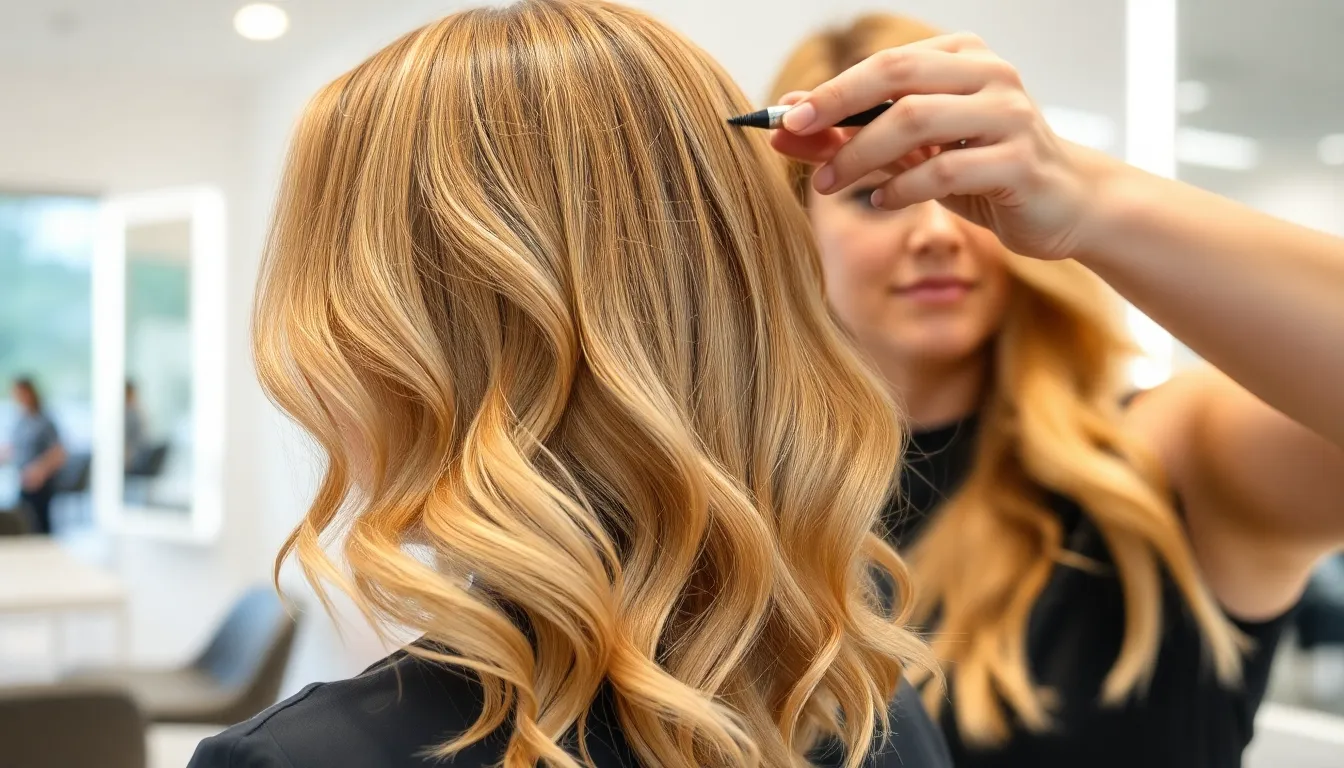
Champagne blonde captures the effervescent elegance of fine sparkling wine through its sophisticated blend of warm golden undertones and cool beige highlights. This luxurious shade creates multidimensional depth that flatters a wide range of skin tones while maintaining an air of refined sophistication.
Understanding Champagne Color Theory
Color theory forms the foundation of achieving authentic champagne blonde tones through careful balance of warm and cool pigments. Professional colorists combine level 8-9 blonde bases with subtle beige and golden undertones to replicate the natural shimmer found in champagne bubbles. The key lies in maintaining approximately 60% warm golden tones balanced with 40% cool beige undertones to prevent the color from appearing too brassy or ashy.
Base pigments must be lifted to level 9 or higher to accommodate the delicate champagne formulation without compromising color integrity. Toner selection becomes crucial at this stage, with beige and pearl toners providing the signature champagne depth while maintaining luminosity. We recommend using toners with violet and green bases to counteract any unwanted yellow or orange undertones that might interfere with the champagne effect.
Natural undertones in your existing hair color significantly impact the final champagne result, requiring customized formulation approaches for optimal outcomes. Darker starting points may need pre-lightening sessions spaced 2-3 weeks apart to prevent excessive damage while achieving the necessary lift. Color placement strategies should focus on creating natural-looking dimension through strategic highlight and lowlight combinations that mimic how light naturally reflects off champagne liquid.
Professional Color Application Tips
Application techniques for champagne blonde require precise sectioning patterns and strategic color placement to achieve the multidimensional champagne effect. We start with horizontal sections measuring approximately 1/4 inch thickness, allowing for even product distribution and consistent lift throughout the hair shaft. Foiling techniques work best for champagne blonde application, as they provide controlled heat distribution and prevent color bleeding between sections.
Timing becomes critical during the lightening phase, with most hair requiring 35-45 minutes of processing time depending on starting level and desired lift. Professional colorists monitor the lifting process every 10 minutes to ensure even development and prevent over-processing that could compromise hair integrity. The sweet spot occurs when hair reaches level 8-9 with minimal yellow undertones remaining.
Toner application follows immediately after the lightening process, using a 1:2 ratio of toner to developer for optimal color deposit and longevity. We apply toner from mid-length to ends first, then work toward the roots to prevent over-processing in areas that lift fastest. Processing time for champagne toners typically ranges from 15-20 minutes, with regular checks to ensure the desired beige-golden balance is achieved.
Root maintenance requires touch-ups every 6-8 weeks to maintain the champagne blonde integrity and prevent noticeable regrowth lines. Between salon visits, we recommend using champagne-toned color depositing shampoos once weekly to refresh the color and maintain vibrancy. Heat styling tools should be limited to 300°F or lower to preserve the delicate champagne tones and prevent premature fading.
Butter Blonde: Creamy Soft Yellow Tones
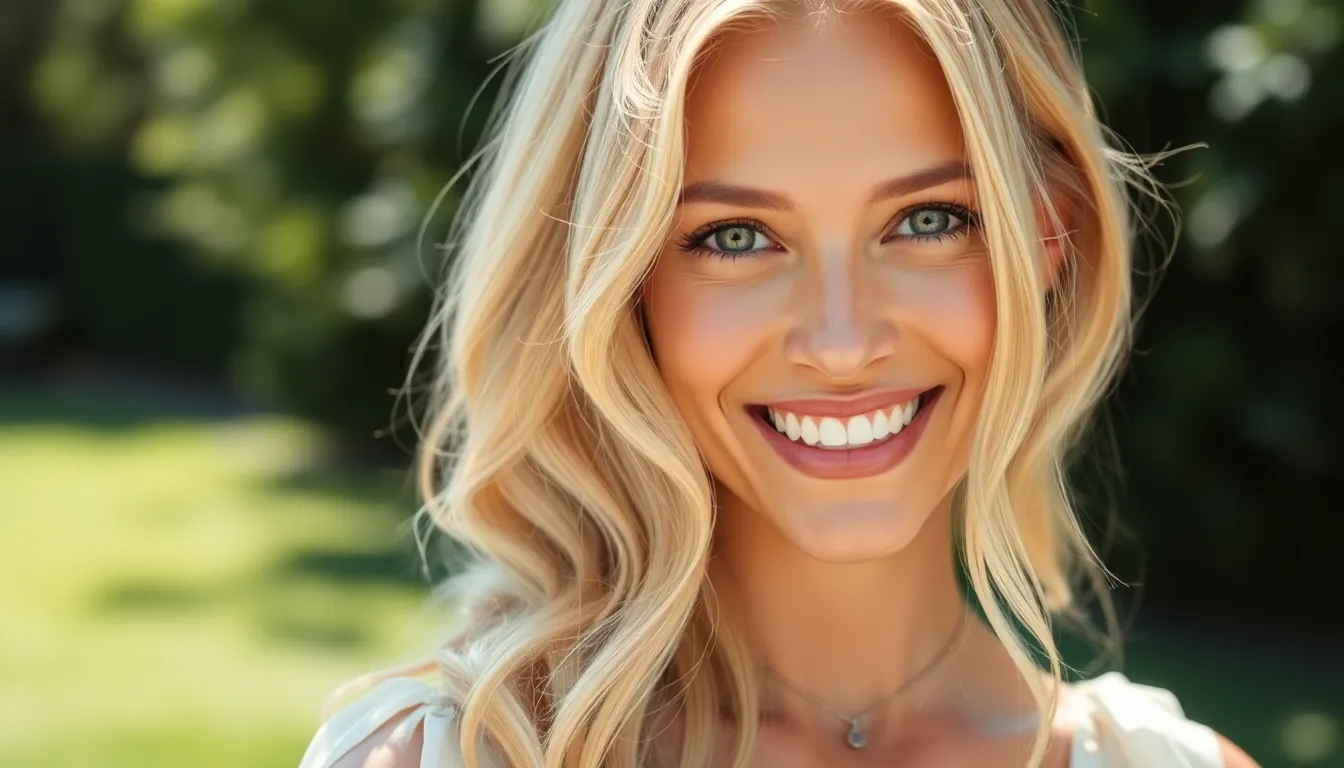
Butter blonde delivers the perfect balance of warmth and softness, creating luxurious creamy yellow tones that radiate natural beauty. This shade captures the essence of fresh butter with its rich golden undertones that complement warm skin complexions beautifully.
Creating Seamless Butter Blonde Blends
Professional colorists achieve butter blonde through strategic lightening techniques that preserve hair integrity while building dimensional warmth. Foiling methods allow precise control over tone placement, ensuring each strand develops the signature creamy yellow hue without unwanted orange undertones.
Sectioning patterns play a crucial role in creating natural butter blonde depth throughout the hair. We recommend using diagonal partings to mimic how sunlight naturally hits hair, creating organic highlight placement that enhances movement and texture.
Timing becomes essential during the lightening process to achieve optimal butter tones. Most clients require 30 to 45 minutes of processing time, depending on starting color and desired intensity. Professional colorists monitor lift levels carefully to prevent over processing while ensuring complete yellow pigment development.
Color formulation for butter blonde typically combines level 8 and 9 shades with golden and yellow bases. Toner selection focuses on improving natural warmth rather than neutralizing it, using gold and honey based products to amplify the buttery finish.
Protecting Color Vibrancy
Butter blonde maintenance requires exact products designed to preserve yellow tones and prevent fading. Color safe shampoos with gentle sulfate free formulas help maintain the creamy finish while protecting against environmental damage.
Weekly deep conditioning treatments become essential for butter blonde hair health and color longevity. Professional grade masks containing keratin and natural oils restore moisture balance while sealing color molecules within the hair shaft.
Heat protection proves vital for maintaining butter blonde vibrancy during styling. Thermal sprays with UV filters shield hair from both heat damage and sun exposure that can cause unwanted color shifts or fading.
| Maintenance Schedule | Frequency | Purpose |
|---|---|---|
| Professional touch ups | 6-8 weeks | Color refresh and root maintenance |
| Deep conditioning | Weekly | Moisture restoration and color protection |
| Toning treatments | 4-6 weeks | Yellow tone enhancement |
| Gloss applications | 8-10 weeks | Shine and color deposit |
Color depositing shampoos specifically formulated for butter blonde shades help maintain warmth between salon visits. These products contain yellow and gold pigments that refresh the creamy tones while cleansing gently.
Professional gloss treatments every 8 to 10 weeks add incredible shine while depositing fresh butter blonde pigments. These semi permanent services enhance color depth and create mirror like reflection that showcases the dimensional yellow tones perfectly.
Sandy Blonde: Beach-Inspired Natural Beauty

Sandy blonde captures the effortless beauty of sun-bleached hair with its perfect blend of warm beige and golden undertones. We love how this versatile shade mimics the natural lightening effects of ocean salt and summer sunshine.
Multi-Dimensional Sandy Techniques
Foil weaving creates the foundation for authentic sandy blonde dimension by strategically placing lighter pieces throughout the mid-lengths and ends. Professional colorists use varying foil thicknesses to achieve natural-looking depth, alternating between fine highlights and broader ribbons of color.
Root shadowing maintains the beachy authenticity by keeping deeper tones at the scalp while gradually transitioning to lighter sandy hues. We recommend using a shade two to three levels darker than the lightest pieces to create seamless gradient effects.
Balayage application mimics natural sun exposure patterns by painting color onto the hair’s surface in sweeping motions. Master colorists focus placement on areas where sunlight would naturally hit, including the hairline, crown, and outer sections of longer lengths.
Tonal layering involves multiple color applications to build complexity within the sandy spectrum. Base colors range from level 6 to 8, while highlight tones extend from level 8 to 10, creating rich dimensional effects that shift beautifully in different lighting conditions.
Seasonal Color Adjustments
Summer enhancement involves brightening the sandy base by one to two levels to capture peak beach season vibes. We typically add more golden undertones during warmer months, using honey-based toners to amplify the sun-kissed appearance.
Winter deepening requires adding subtle ash undertones to prevent the color from appearing too warm against cooler seasonal palettes. Professional colorists incorporate beige and mushroom tones to maintain the sandy essence while adapting to fall and winter fashion trends.
Spring refreshing focuses on removing any unwanted brassiness that may have developed during winter months. We use violet-based toners to neutralize yellow buildup while maintaining the warm sandy character that defines this beloved shade.
Touch-up timing varies by season, with summer requiring visits every 8-10 weeks due to increased sun exposure and swimming activities. Winter maintenance extends to 10-12 weeks as the hair experiences less environmental stress and fading occurs more gradually.
Vanilla Blonde: Soft Neutral Perfection
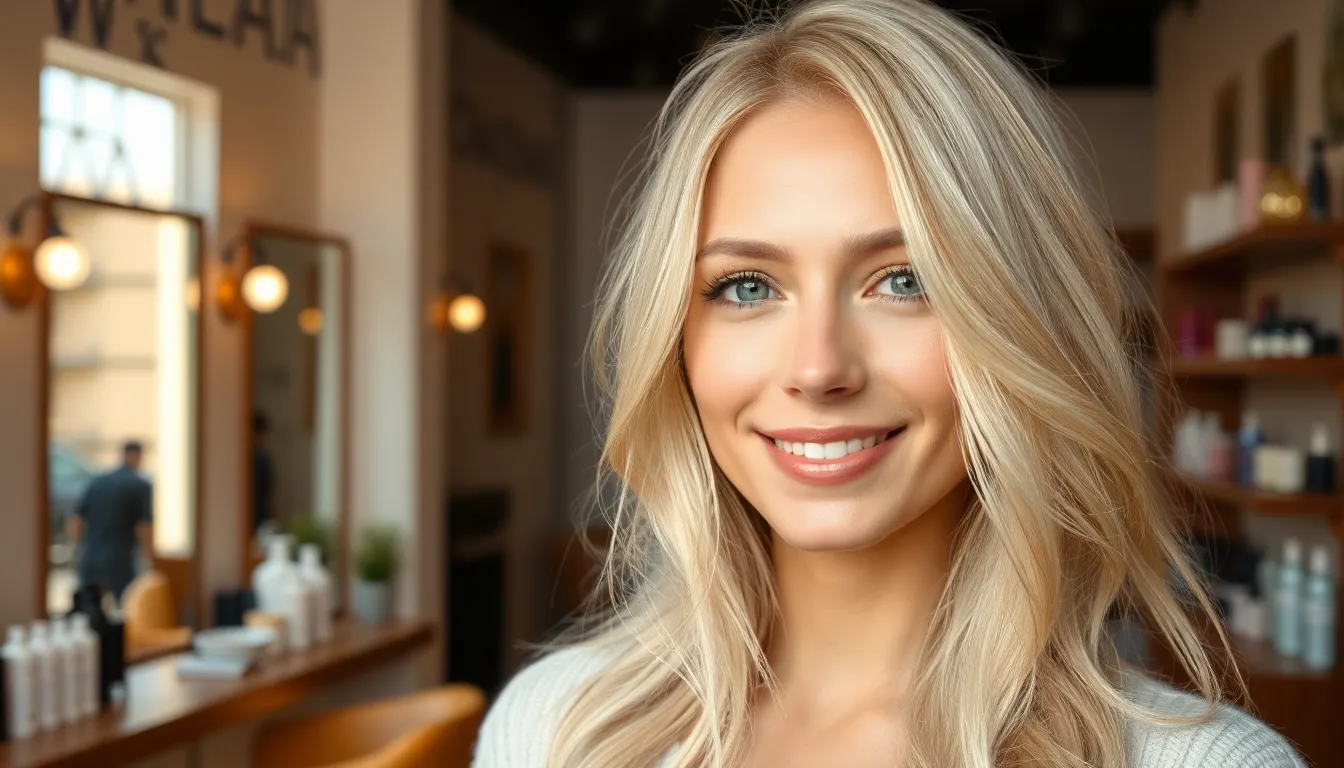
Vanilla blonde embodies effortless sophistication with its creamy neutral tones that complement virtually every skin type. This versatile shade creates a soft dimensional effect through carefully balanced warm and cool undertones.
Customizing Vanilla Tones
Base customization begins with analyzing your natural undertones to create the perfect vanilla formula. Cooler skin tones benefit from slightly ashy vanilla blends, while warmer complexions shine with golden vanilla variations.
Professional colorists adjust the lightening level to achieve optimal vanilla results. Level 8 bases work beautifully for deeper vanilla tones, while level 9 creates brighter vanilla expressions. Your colorist will determine the precise lightening needed based on your starting color and desired vanilla intensity.
Toner selection plays a crucial role in vanilla blonde customization. Beige toners eliminate unwanted yellow pigments while maintaining warmth. Neutral ash toners create cooler vanilla variations. Pearl toners add luminous dimension to vanilla bases.
Placement techniques enhance vanilla blonde’s natural appeal through strategic highlighting patterns. Partial highlights create subtle vanilla accents throughout darker bases. Full highlights deliver complete vanilla transformation with seamless blending. Babylights add delicate vanilla touches that mimic childhood hair lightening.
Color Correction for Vanilla Blonde
Brassiness removal requires exact corrective measures when vanilla blonde turns too yellow or orange. Blue based toners neutralize orange undertones effectively. Violet based toners eliminate yellow pigments that compete with vanilla’s soft neutrality.
Previous color history affects vanilla blonde achievement and may require additional correction steps. Dark box dye requires professional color removal before vanilla application. Red pigments need specialized lifting techniques to prevent muddy vanilla results. Gray coverage demands careful formulation to maintain vanilla’s soft appearance.
Processing time adjustments prevent vanilla blonde from becoming too ashy or too warm during correction. Shorter processing creates subtle vanilla shifts on previously lightened hair. Extended processing achieves dramatic vanilla transformation on darker starting colors. Your colorist monitors development every 10 minutes to ensure perfect vanilla results.
Touch up timing varies based on your hair’s porosity and previous chemical treatments. Virgin hair holds vanilla blonde for 8 to 10 weeks between appointments. Previously lightened hair may need vanilla refreshing every 6 to 8 weeks. Damaged hair requires more frequent vanilla maintenance to prevent color fading and maintain healthy appearance.
Caramel Blonde: Rich Warm Highlights
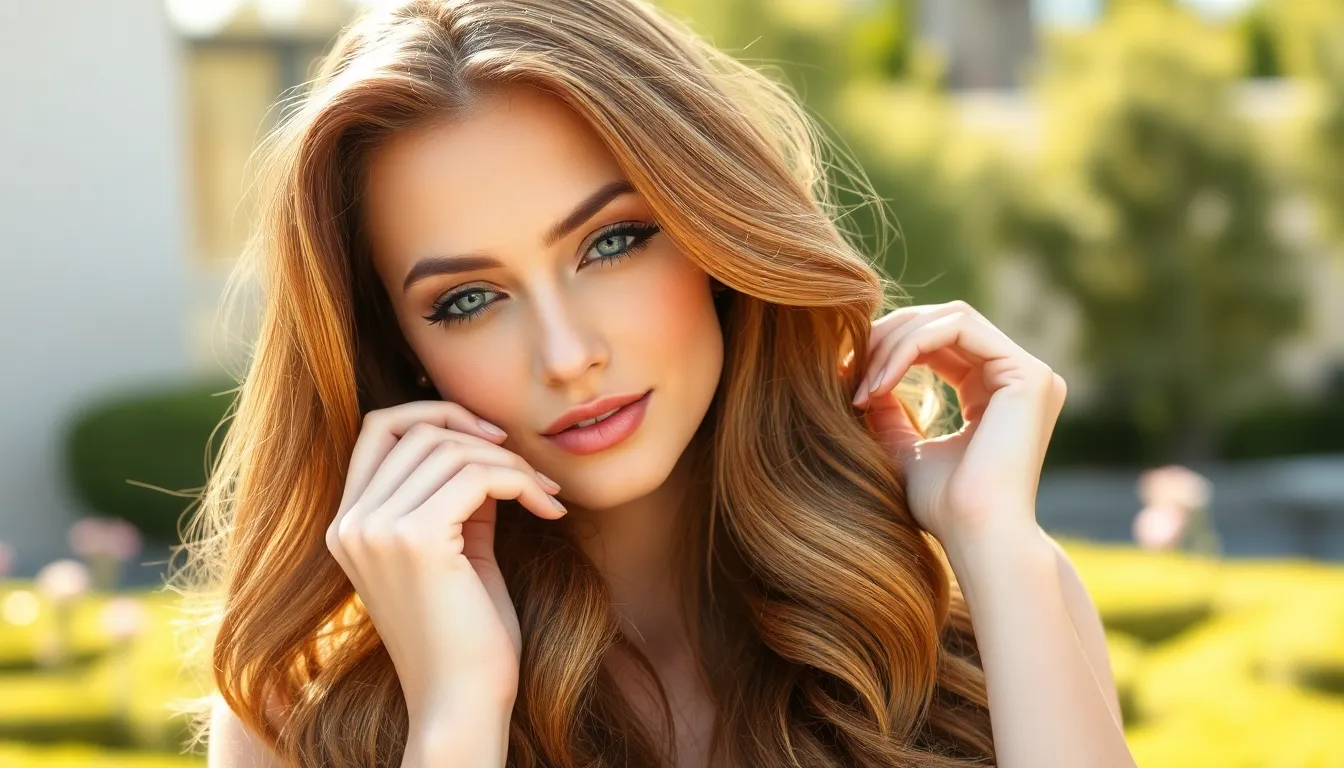
Caramel blonde transforms hair with luxurious amber-infused tones that create depth and richness. This multidimensional shade combines golden highlights with deeper blonde undertones for a naturally sun-kissed appearance.
Placement Techniques for Caramel
Strategic foil placement creates the perfect caramel blonde dimension by targeting exact sections for lightening. We recommend starting with the face-framing pieces to enhance features and add warmth around the complexion.
Balayage application works beautifully for caramel tones by painting highlights onto surface sections while maintaining natural root depth. Professional colorists use vertical sectioning patterns to ensure seamless blending throughout the mid-lengths and ends.
Root shadowing preserves darker undertones at the base while allowing caramel highlights to develop naturally down the hair shaft. This technique creates a lived-in look that requires less frequent touch-ups.
Diagonal sectioning enhances movement and flow by creating organic highlight patterns that mimic natural sun exposure. We suggest varying the width of each section to avoid uniform striping and maintain authenticity.
Complementary Lowlight Options
Chocolate brown lowlights complement caramel highlights by adding contrast and preventing the overall color from appearing flat. These deeper tones create definition while maintaining warmth throughout the blonde base.
Espresso lowlights work exceptionally well for clients seeking more dramatic depth alongside their caramel highlights. We position these darker accents strategically underneath the top layer to add richness without overwhelming the lighter tones.
Honey lowlights bridge the gap between caramel highlights and natural base colors for a cohesive multidimensional result. This complementary approach ensures smooth color transitions and eliminates harsh lines.
Toffee toned lowlights enhance the overall warmth of caramel blonde while adding subtle complexity to the color palette. These medium brown accents work particularly well for maintaining natural movement and preventing excessive lightness.
Rose Gold Blonde: Trendy Pink-Infused Glamour
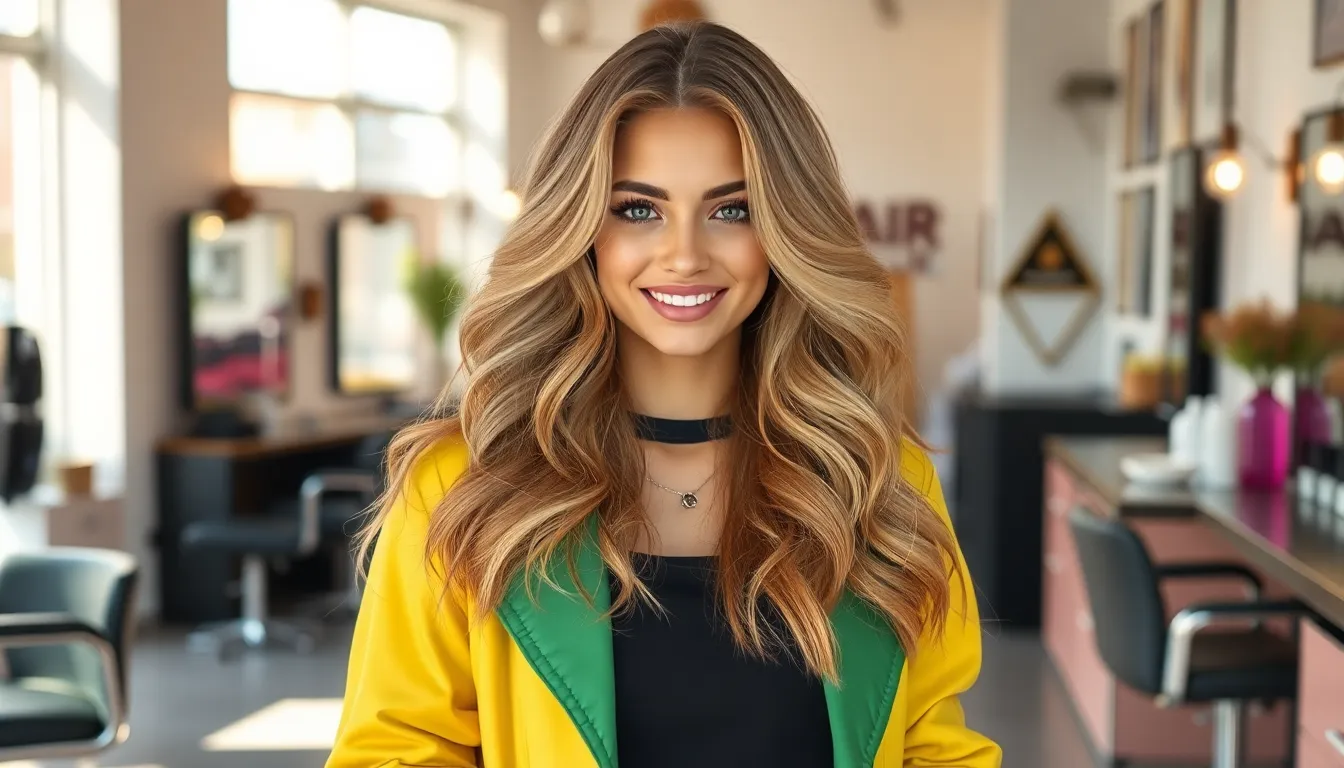
Rose gold blonde transforms traditional blonde hair into a modern masterpiece by incorporating subtle pink undertones that catch light beautifully. This Instagram-worthy shade appeals to fashion-forward individuals seeking a unique twist on classic blonde.
Achieving Rose Gold Undertones
Professional colorists create rose gold blonde by first lightening hair to a pale yellow base using bleach formulations. Toning follows with exact pink-based color cocktails that deposit rosy hues without overwhelming the blonde foundation. We recommend achieving a level 9 or 10 lightness before applying rose toners to ensure proper color absorption.
Color placement techniques vary based on your desired intensity and natural hair texture. Foil highlights allow for precise pink deposit in selected strands while maintaining blonde contrast throughout. Balayage application creates a more diffused rose gold effect that blends seamlessly with your natural blonde tones.
Timing proves critical when processing rose toners since pink pigments develop quickly on pre-lightened hair. Professional colorists monitor development every 5 minutes to prevent over-toning which can result in unwanted purple or magenta hues. We suggest starting with shorter processing times and building intensity gradually through multiple applications.
Color formulation requires careful balance between pink and peach undertones to achieve authentic rose gold results. Mixing ratios typically include 60% pink base with 40% peach modifier to create dimensional warmth. Professional lines offer pre-mixed rose gold toners that eliminate guesswork while ensuring consistent results across appointments.
Temporary vs. Permanent Rose Gold Options
Temporary rose gold answers include color depositing shampoos, glosses, and wash-out tints that last 2-6 washes. These products work best on pre-lightened blonde hair since they lack ammonia to lift natural pigment. We recommend temporary options for first-time rose gold experimenters or those wanting seasonal color changes.
Semi-permanent rose gold formulas penetrate the hair cuticle without developer and typically last 4-8 weeks depending on porosity. These products fade gradually through shampooing and heat styling while maintaining some pink undertones longer than temporary alternatives. Professional semi-permanent lines offer superior color payoff and longevity compared to drugstore versions.
Permanent rose gold blonde requires commitment since the pink pigments integrate with your hair structure through oxidative processing. Developer strengths of 10-20 volume lift natural pigment while depositing rose tones simultaneously. We advise consulting professional colorists for permanent applications to prevent damage and ensure desired results.
Color maintenance varies significantly between temporary and permanent rose gold options requiring different care approaches. Temporary formulas benefit from color-safe shampoos and minimal heat styling to extend vibrancy. Permanent rose gold needs specialized pink-improving products and regular toner refresh appointments every 6-8 weeks to maintain optimal color intensity.
Bronde: The Best of Both Blonde and Brunette Worlds
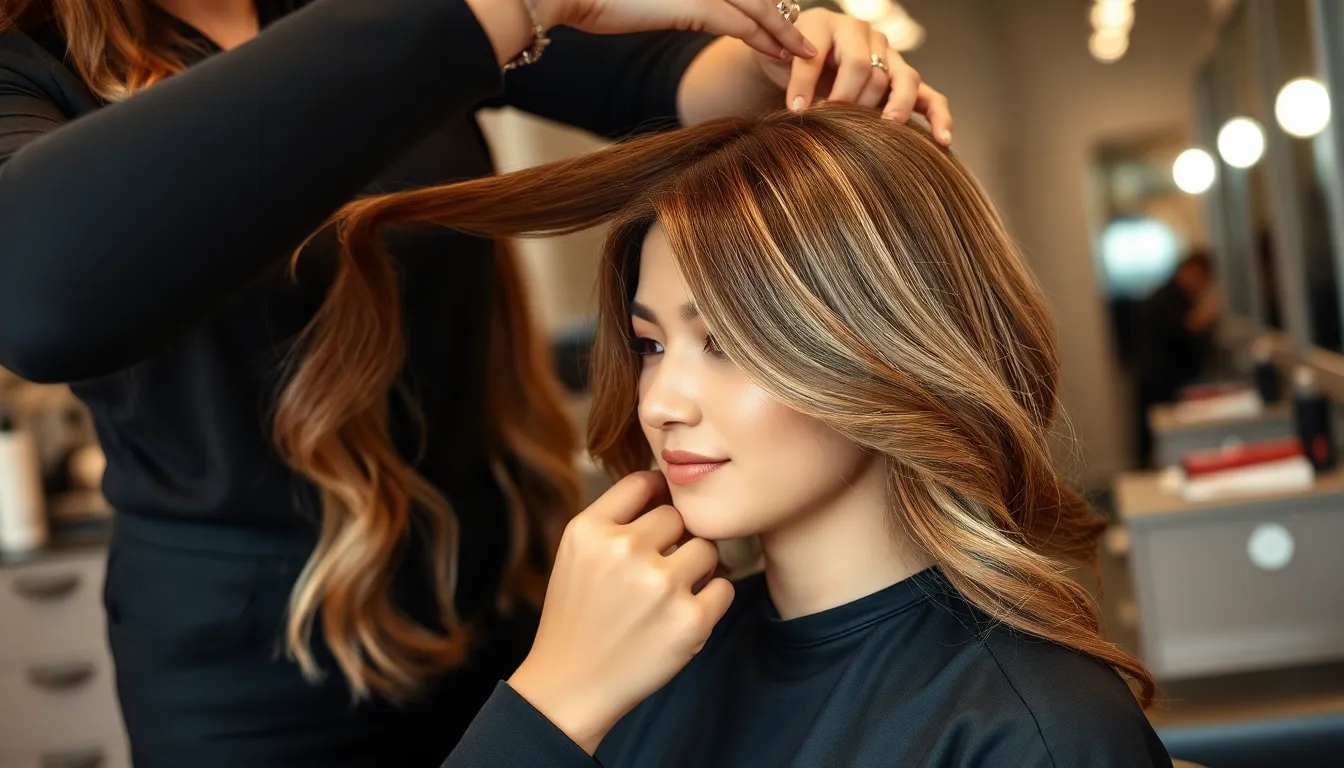
Bronde combines the sophistication of brunette depth with blonde brightness, creating a versatile shade that offers dimensional beauty without the maintenance demands of full blonde. This hybrid color delivers the perfect compromise for those seeking warmth and complexity in their hair transformation.
Balancing Blonde and Brown Tones
Professional colorists achieve stunning bronde by strategically placing blonde highlights through brunette bases, creating natural-looking dimension that mimics sun-bleached hair. The key lies in maintaining a 60-40 ratio, with brunette tones dominating the deeper sections while blonde accents illuminate the mid-lengths and ends.
Foil placement determines the final bronde outcome, with colorists focusing on face-framing highlights and scattered pieces throughout the crown area. We recommend using a medium brown base color with caramel and honey blonde highlights to achieve the most flattering bronde effect.
Toner selection becomes crucial for balancing warm and cool undertones within the bronde spectrum. Golden-based toners enhance warmth in the blonde sections while ash-based options can neutralize any unwanted brassiness that might compete with the brunette foundation.
Color melting techniques ensure seamless transitions between the blonde and brown sections, preventing harsh lines that can make bronde appear unnatural. Professional stylists use root shadowing to maintain depth at the scalp while gradually lightening toward the ends for a sun-kissed gradient.
| Bronde Technique | Application Method | Maintenance Frequency |
|---|---|---|
| Foil highlights | Sectional weaving | 8-10 weeks |
| Balayage | Freehand painting | 10-12 weeks |
| Color melting | Root to end blending | 12-14 weeks |
| Root shadowing | Deeper root application | 6-8 weeks |
Customizing Bronde for Face Shape
Round faces benefit from bronde placement that creates vertical lines through longer highlight sections around the perimeter, adding length and drawing attention upward. We focus blonde pieces around the jawline and cheekbone areas to enhance facial contours while keeping darker tones at the crown for added height.
Square face shapes require softer bronde application with curved highlight patterns that complement angular features. Colorists place blonde sections asymmetrically to break up harsh lines while maintaining brunette depth around the temples for a more oval appearance.
Heart-shaped faces shine with bronde color that adds width at the jawline through strategic blonde placement in the lower sections. We recommend concentrating darker brunette tones at the crown while gradually introducing blonde highlights from the ears down to balance proportions.
Oval faces can accommodate virtually any bronde variation, allowing for creative freedom in highlight placement and color intensity. These versatile face shapes work beautifully with both subtle bronde effects and more dramatic blonde-to-brown contrasts.
Long faces benefit from horizontal bronde placement that creates width through side-swept highlights and strategic color breaks. We suggest adding blonde pieces at eye level and around the ears to draw attention outward while using brunette tones to minimize vertical emphasis.
White Blonde: Bold Statement Platinum
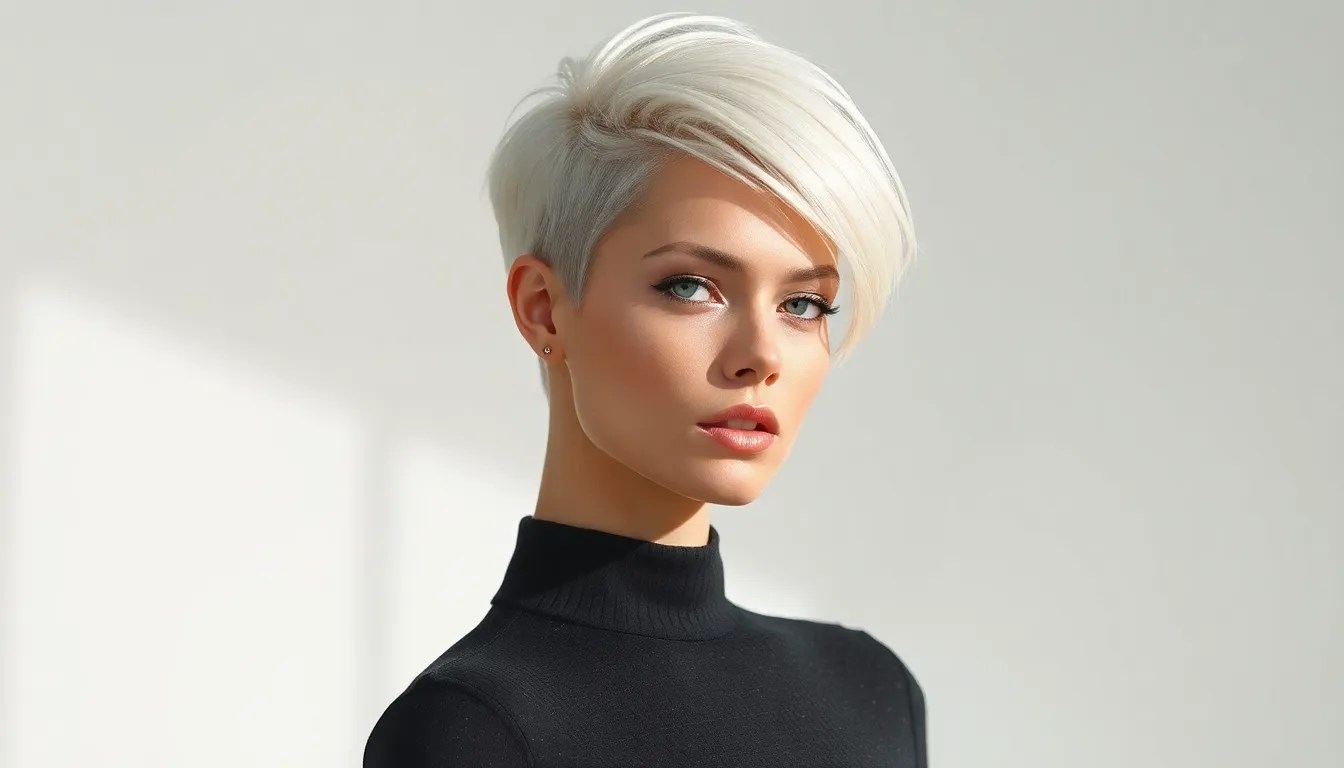
White blonde represents the most dramatic end of the platinum spectrum, delivering an ultra-cool shade that commands attention. This striking color choice transforms your look into a high-fashion statement that exudes confidence and modern edge.
Bleaching Requirements for White Blonde
Achieving white blonde demands multiple bleaching sessions to reach the palest possible base. We recommend starting with virgin hair or hair that hasn’t been colored in at least six months for optimal results. Professional colorists typically require 3-4 bleaching appointments spaced 2-3 weeks apart to safely lift hair to the necessary level 10+ base.
Pre-lightening treatments become absolutely crucial when pursuing white blonde tones. Bond-building products like Olaplex or K18 protect hair structure during the intensive lifting process. Colorists apply these treatments before, during, and after each bleaching session to maintain hair integrity.
Timing varies significantly based on your starting color and hair condition. Natural level 3-4 brunettes need 12-16 weeks to reach white blonde safely, while level 6-7 blondes can achieve this look in 6-8 weeks. Never attempt to rush this process, as damaged hair won’t hold the pristine white tone you’re seeking.
| Starting Hair Level | Sessions Required | Timeline | Maintenance Frequency |
|---|---|---|---|
| Level 3-4 (Dark Brown) | 4-5 sessions | 12-16 weeks | Every 4-5 weeks |
| Level 5-6 (Medium Brown) | 3-4 sessions | 9-12 weeks | Every 5-6 weeks |
| Level 7-8 (Light Brown/Blonde) | 2-3 sessions | 6-8 weeks | Every 6-7 weeks |
Toning and Maintenance Essentials
White blonde requires precise toning to eliminate any remaining yellow or brassy undertones. Professional colorists use high-lift violet and blue-based toners to neutralize warmth completely. The toning process typically takes 15-20 minutes and must be monitored carefully to prevent over-toning.
Purple shampoo becomes your daily essential for maintaining white blonde vibrancy. We suggest using purple shampoo 3-4 times per week, alternating with moisturizing shampoo to prevent dryness. Deep conditioning treatments should happen weekly to restore moisture and protein balance.
Professional gloss applications every 4-6 weeks refresh the white tone and add incredible shine. These treatments deposit subtle pigments while sealing the hair cuticle for enhanced light reflection. Your colorist will customize the gloss formula based on any tone shifts that occur between appointments.
Heat protection becomes non-negotiable with white blonde hair. UV damage appears more dramatically on lightened hair, so we recommend using leave-in treatments with SPF protection. Ceramic styling tools set to 300°F or lower prevent unnecessary damage while maintaining your sleek white blonde finish.
Weekly protein treatments help strengthen compromised hair bonds from the extensive bleaching process. Alternate between protein and moisture treatments to maintain the perfect balance your white blonde hair needs to stay healthy and vibrant.
Conclusion
We’ve explored the stunning industry of blonde hair colors and discovered that finding your perfect shade isn’t just about following trends—it’s about understanding what works best for your unique features and lifestyle. From the sophisticated elegance of platinum to the warm embrace of honey blonde each shade offers its own personality and charm.
The key to blonde success lies in professional application and dedicated maintenance. Whether you’re drawn to the subtle sophistication of champagne blonde or the bold statement of white blonde investing in quality products and regular salon visits will keep your color looking fresh and healthy.
Remember that your blonde journey is personal. What matters most is choosing a shade that makes you feel confident and beautiful while complementing your natural undertones and fitting seamlessly into your daily routine.
Frequently Asked Questions
What blonde shade works best with my skin tone?
The key is matching undertones. Cool skin tones with pink or blue undertones pair beautifully with platinum, ash, or white blonde. Warm undertones with yellow or peach hues complement honey, strawberry, butter, or caramel blonde. Neutral undertones can wear most shades, including vanilla blonde and champagne blonde, which offer versatile sophistication.
How often do I need touch-ups for different blonde shades?
Maintenance frequency varies by shade and technique. High-maintenance colors like platinum and white blonde need touch-ups every 4-6 weeks. Low-maintenance options like dirty blonde, bronde, and sandy blonde can go 8-12 weeks between appointments. Balayage techniques generally require less frequent maintenance than traditional foil highlights.
Can I achieve platinum blonde at home or do I need a professional?
Platinum blonde requires professional expertise due to multiple bleaching sessions and precise toner application. The process involves pre-lightening treatments, careful timing, and purple or silver toners to achieve the perfect icy finish. Attempting this at home risks severe damage, uneven results, and unwanted yellow tones.
What’s the difference between ash blonde and platinum blonde?
Ash blonde features cool gray and blue undertones that neutralize warmth while maintaining some depth. Platinum blonde is the ultimate cool-toned shade – nearly white with maximum lightness and sophistication. Both eliminate yellow tones, but platinum requires more extensive bleaching and offers a more dramatic, modern look.
How do I maintain my blonde color between salon visits?
Use purple shampoo weekly to neutralize brassiness, apply deep conditioning treatments regularly, and protect hair from sun exposure. Color-safe shampoos preserve vibrancy, while color depositing shampoos maintain warmth in honey and caramel tones. Professional gloss treatments every 6-8 weeks enhance shine and extend color life.
What is bronde and who should consider it?
Bronde combines brunette depth with blonde brightness, typically maintaining a 60-40 brunette-to-blonde ratio. It’s perfect for those wanting dimensional color without high maintenance. This low-maintenance hybrid works well on various skin tones and offers natural sun-kissed effects through strategic highlight placement using balayage or foil techniques.
Is rose gold blonde suitable for all hair types?
Rose gold blonde works on most hair types but requires lightening to a pale yellow base first. The pink undertones complement various skin tones, offering a modern twist on traditional blonde. Temporary options allow experimentation, while permanent applications need professional consultation to ensure proper color formulation and maintenance.
How do I prevent damage when going blonde?
Use bond-building treatments during bleaching, apply heat protectant before styling, and maintain regular deep conditioning routines. Limit heat styling, protect hair from sun exposure, and schedule regular professional treatments. Gradual lightening over multiple sessions prevents excessive damage while achieving desired results safely.
What’s the best blonde shade for low maintenance?
Dirty blonde and sandy blonde offer the lowest maintenance, requiring touch-ups every 8-12 weeks. These shades blend natural growth seamlessly and work well with various techniques like balayage and root shadowing. Bronde is another excellent low-maintenance option that combines depth with brightness naturally.
Can I switch between different blonde shades easily?
Switching blonde shades depends on your current color and desired result. Moving from lighter to darker shades is easier than the reverse. Color correction may be necessary when changing undertones significantly. Professional consultation ensures safe transitions while maintaining hair health and achieving your desired blonde transformation.

